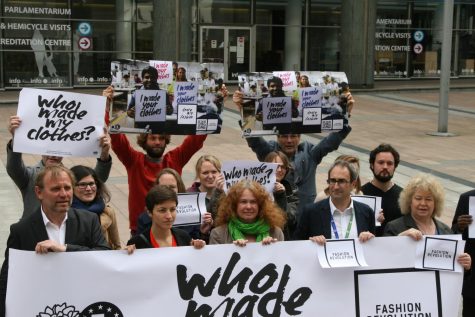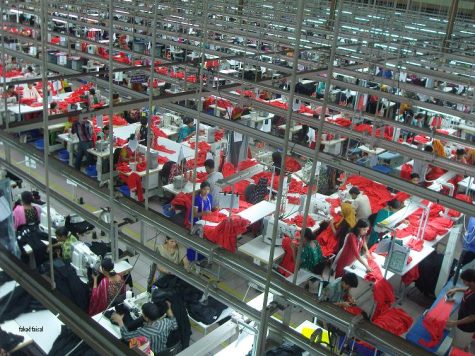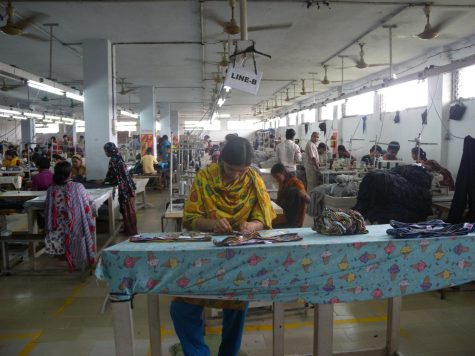Fast Fashion: Reminder of the Social Environmental Responsibility of Consumers
As the back-to-school season hits its peak, reminder to all high schoolers of the slippery slope that is fast fashion.
November 28, 2023
What is fast fashion?
Fast fashion is exactly what it sounds like— it is a term referring to clothing companies that prioritize fast design, fast manufacturing, and fast delivery to the market where they will sell cheaply made garments to eager consumers. Even these consumers can be described as “fast” acting, as studies have shown that 1 in 3 Gen Z reported they feel addicted to fast fashion and 72% of college students said that they have shopped fast fashion in the past year (thredUP Gen Z Fast Fashion Report).
Finally, fast fashion trends are changing more rapidly than ever, particularly due to the impact of COVID-19. It seems to be there is a lot more attention on Gen Z and others’ clothing, and as a result there has been high pressures on workers, low clothing prices, and demand from these companies.

Why go fast fashion? Why is it relevant to us?
There are a number of reasons why fast fashion is alluring. One of the most known brand names to date is SHEIN, a Chinese fast fashioned company that has only risen since its creation in 2012.
Saving money on clothes is a priority to many, especially teenagers— which is completely reasonable, right? There are also many individuals who cannot afford higher-priced clothing items, and as a result, the popularity of fast fashion increases. Regardless of the reason why someone prioritizes affordability, we know that it is simply nature. In fact, according to the 2021 thredUP Resale Report, 60% of the post-COVID-19 consumers are more opposed to wasting money than before the pandemic.
The low prices of fast fashion items then enable the consumer to buy more, and more, and more. But the problem with that is the quality of clothing decreases, given that the demand for fast-fashion clothes is already so high. The low prices are also what allow popular companies to make so much money. These companies optimize the selling price and wage that they pay the workers in order to maximize their profit.
Of course, teenagers and other consumers are not just buying clothes from these brands simply due to the prices (often in the 1-digit values). It is the design and the low price put together that is desirable— This, and the vast inventory of designs and clothing pieces together? It makes for an even deadlier selling point. According to data collected by Rest of World, 2,000 and 10,000 individual styles are added to SHEIN’s app every day.
Fast fashion outfits tend to be popular for one-time events, like concerts and parties. Take this year’s Governor’s Ball, for example. An annual music festival on Governors Island in New York City. The outfit trends at music events such as these include crop tops with pops of color in various styles. Senior Willem Davidson, who went to the concert, said, “I assume that the majority of outfits came from cheaper, fast fashion brands like SHEIN, even if I couldn’t directly tell.” What tends to happen in these situations is that the clothing is worn once and then discarded, or dumped in a thrift shop, which isn’t much better as it usually stays on the rack due to wear or poor quality.
Finally, many people are not aware that a certain clothing company that they buy clothes from is in fact a fast fashion brand. In other cases, some might be unaware of the magnitude to which fast fashion is harmful— sustainability wise and ethically.
Many people also argue that certain companies are “not as bad,” and although it is better to support some businesses over others (given that you put in proper research and know your facts) all fast fashion consumerism feeds into an overarching idea— impulse:

Making Choices:
Just like how many addictions take form, it’s the argument of “just this once” or “but it’s just so easy” that fuels the problem. Evaluating your social responsibility as a consumer is just as important as acknowledging the responsibilities coming from the other side, that is, the business. Many people want to stop buying fast fashion: 40% of college students browse fast fashion sites or apps at least once a day, if not more, and while 51% of college students say they want to quit fast fashion or shop it less, how many of them really do? (thredUP Gen Z Fast Fashion Report).
Labor Conditions and Controversy
The other concern about fast fashion is the exploitive methods that companies take. For example, in a documentary by Channel 4, an undercover investigation on SHEIN was conducted. It was discovered that factory workers worked 18 hour shifts, with no weekends off, and with only one day off per month. Additionally, the investigation uncovered the “culture of design theft,” in which the company has been stealing fashion designs from individual designers. The exploitation and labor conditions of SHEIN factories is a serious problem, and buying from companies like SHEIN only propels it.
Sustainability— How does the fashion industry contribute to the climate and what can you do to help?
As mentioned earlier, many fast fashion items are dumped in the trash or at second hand shops due to their poor quality. Though second hand shopping and thrifting is a very effective way to reduce carbon footprint and buy clothes in a sustainable way, it is not when these items just sit on the shelves, as they often offer very little interest to thrifters.

The fashion industry alone contributes 8% of all carbon emissions and 20% of all global wastewater, with an anticipated 50% increase in greenhouse gas emissions by 2030 (Multidisciplinary Digital Publishing Institute).
The waste only increases from thrown out clothes: It is estimated that 36 billion items of clothes are thrown away in the US per year. The difference between buying a new and used item is a displacement of 17.4 billion pounds of CO2 emissions and 82% carbon footprint. This leads to a solution to buying fast fashion. Simply put, if one were to buy a fast fashion item, they would be contributing to that 17.4 billion lbs of CO2 emissions, vs. if they bought just one used item instead, it would be saving that 17.4 billion lbs of CO2 emissions and reduce the carbon footprint by 82% (2021 thredUP Resale Report).

Now, it’s sometimes hard to completely avoid fast fashion. Many fast fashion brands that you may not be aware of are H&M, Zara, UNIQLO, Urban Outfitters, Forever 21, Hollister, and so many more. The debate of buying from fast fashion brands also comes down to accessibility, which is just as important. However, measures can be taken to avoid these brands. Measures must be taken to avoid these brands, as it is summarized that to increase sustainability in the fashion industry, it is up to social environmental responsibility, sustainability governance, and company policies to make changes. That includes you.
With the back-to-school season in full swing, you are presented with a large opportunity to take on such environmental responsibility and stay away from major fast fashion brands. 71% of college students plan to buy new clothes, meaning a similar equivalent is likely true with high school students (thredUP Gen Z Fast Fashion Report). As you go shopping for the new hottest styles, think twice before clicking the “Add to Cart” button; the future of the planet depends on your choices.







